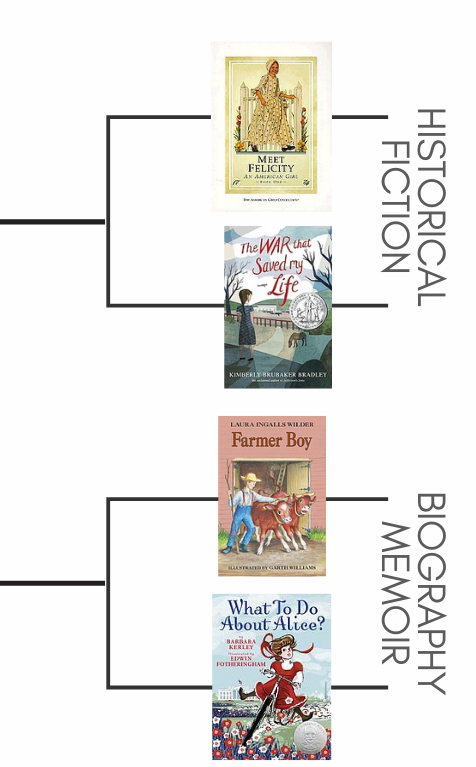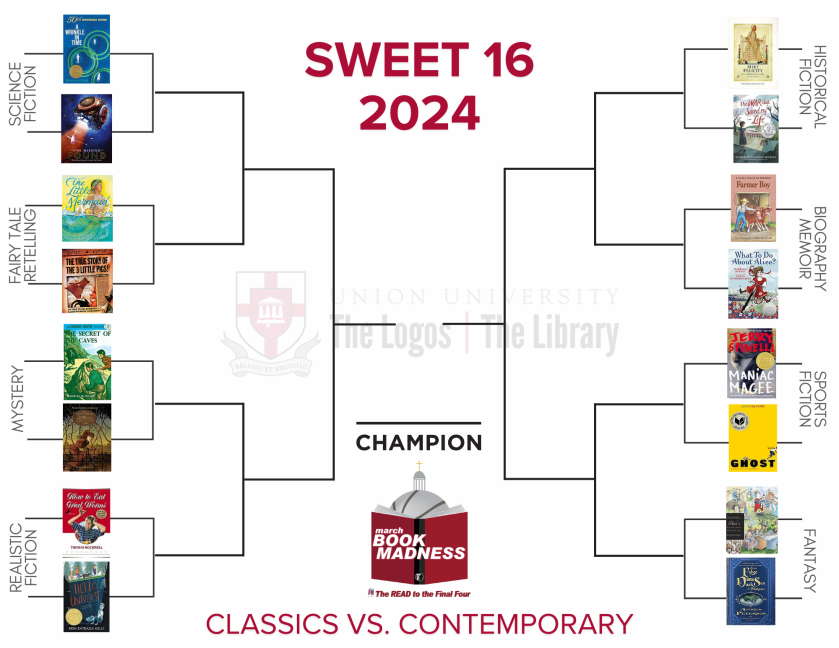
Announcer: We are ready for Week 2 of March Book Madness 2024. You were introduced to our Mystery and Realistic Fiction genres last week, but now it’s time to move in a different direction. Rachel and Darius will be presenting their selections for Historical Fiction and Biography/Memoir. Rachel is up first with Historical Fiction. Rachel, can you introduce yourself, tell us some about your genre, and give the readers some information about your classic pick?
Rachel: Hi. Yes, I’m Rachel, the Circulation Manager of the Logos, and I’m excited to help introduce this next genre. Historical Fiction is a genre that I read a lot, and simply put, it is a fictional story based during a specific time period or event that took place in the past. While reading, you must be careful not to mix fact with fiction, though.
Without further ado, my classic pick is Meet Felicity by Valerie Tripp. It is the first book in the American Girl series based in Colonial Williamsburg and is set around the time of the Revolutionary War. Felicity is nine years old. In this book, she falls in love with a beautiful horse named Penny and seeks to save her from her cruel owner. The series continues with five more books, and you will see Felicity learn to manage some difficult choices as she grows up. This is a series that I owned growing up, and I even had the doll to go along with it. Felicity having a similar hair color to mine has always been something I’ve loved about her.
Announcer: American Girls are a true classic in my eyes. I love that we have so many of the originals in our collection. What is your contemporary pick?
Rachel: My contemporary pick is a book that I often recommend, and it is The War that Saved My Life by Kimberly Brubaker Bradley. Ada, a young girl with a twisted foot, lives in London during World War II. Her mother has often verbally abused her and doesn’t see her worth. When the opportunity arises for the children to be taken to safety in the countryside, Ada’s mother only wants to send her younger brother, Jamie, because she doesn’t think anyone would want to take her with her disability. Ada sneaks away with Jamie, and they end up being placed with a woman named Susan Smith. The story that follows is one that you don’t want to miss.
Announcer: I like that both selections are based around different wars. Which of the two do you think will advance?
Rachel: This is a tough one for me because I love them both. However, I think Meet Felicity being part of a series will help it to advance.
Announcer: Thank you, Rachel. We’ll move now to Darius with the Biography/Memoir genre. Darius, why don’t you introduce yourself and tell us some about your genre, as well as your classic pick?
Darius: I’m Darius, the Evening Circulation Supervisor here at the Union University Library. I’m excited to have the chance to comment on my third March Book Madness! The genre I get to introduce to you today is Biography/Memoir: simply put, these are stories from a person’s life. A biography (or self-written autobiography) aims to tell the story of a person’s life, while memoirs are specific memories from maybe only a portion of a person’s life. Biographies and memoirs are similar enough that we’ve combined them into one category for our purposes.
The classic pick for this category is Farmer Boy by Laura Ingalls Wilder, author of the Little House series. This book is a bit of an outlier in the author’s work, since it’s not about herself, but instead the boy who would become her husband: Almanzo Wilder. I remember my dad reading this one out loud to me when I was probably about the same age as the main character!
Announcer: Sounds like a great pick. What is your contemporary selection? Could you tell us about it and your predicted winner?
Darius: The Biography/Memoir contemporary pick is What to do about Alice? by Barbara Kerley and Ed Fotheringham. This book is a Sibert Honor Book and tells the exciting story of Theodore Roosevelt’s daughter, Alice. We featured it in a What to Read Wednesday last year!
Even though it’s a great one, I think Farmer Boy is more likely to advance into the Elite Eight this year. I think there are probably many readers who, like me, grew up with Laura Ingalls Wilder’s work.
Announcer: We’ll see if either of these predictions hold true when our voting begins in March. Tune in next week for Round 3!




